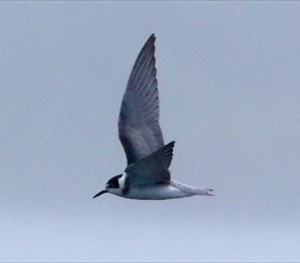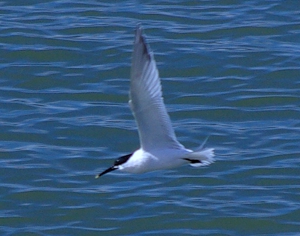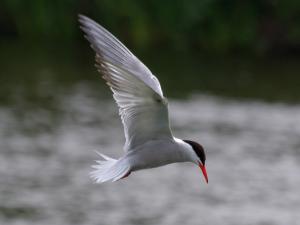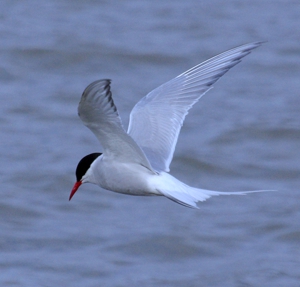


The Black Tern is an uncommon passage migrant to Nottinghamshire, usually with easterly winds in May and murky weather in autumn. Sometimes it can arrive in flocks of 100+, spring 1990 was one such time. In the autumn of 1992 over 300 were at Attenborough on one day.
Sterland and Whitaker in their "List of the Birds of Nottinghamshire {1879}" considered it "a common summer visitor along the course of the Trent".
One pair attempted to breed at Attenborough in 1978, an unusual occurrence as the Black Tern, has not bred in large numbers in England since the early nineteenth century.
Large numbers bred in the fens of neighbouring Lincolnshire in the seventeenth century. There is one report in The Birds of Lincolnshire and South Humberside {Lorand & Atkin} saying "Pennant who visited the East Fens in 1769 was almost deafened by their clamours".

The Sandwich Tern is an uncommon visitor to Nottinghamshire. It occurs every year, mostly in April, May and September. It is usually seen around the gravel pits along the river Trent, Attenborough, Colwick, Holme Pierrepont, Hoveringham etc.
Not recorded by either Sterland or Whitaker in their "List of the Birds of Nottinghamshire {1879}", although F B Whitlock mentions that he saw one on the river Trent in Derbyshire (1893).

The Common Tern was classed as a scarce summer visitor prior to the mid-twentieth century. Sterland said in the "List of the Birds of Nottinghamshire {1879}" that is was frequently seen at that time.
It was first proved to have bred in Nottinghamshire in 1945 at the Nottingham Sewage Farm, but a note by Jack Staton in V40 of British Birds says breeding was suspected in the late 1930s. Since then it has bred mainly on islands at old gravel pits. Attenborough with three purpose built tern platforms can have as many as 40 breeding pairs. Odd birds have bred at other places such as Colwick country park, Kingsmill Reservoir and Lound.
Recoveries of ringed birds suggest that Nottinghamshire's birds winter around Senegal in West Africa. Here they often feed well out to sea, spending the nights up to 300km from shore.

Arctic Terns are scarce passage birds with more being seen in spring than in autumn. This is a similar situation to the mid–nineteenth century when Sterland in the "List of the Birds of Nottinghamshire {1879}" mentioned two birds shot near Newark. The birds are more common in some springs especially when the wind comes from the east and a lot of ‘murk’ covers the county. Whitlock said that Arctic Terns were ‘very common’ in May 1842 in Derbyshire.
Some springs, eg 1998 and 2007, numbers can reach up to as many as 200 birds a day passing along the river Trent.
Any criticisms, corrections or comments to the author Derek Huskisson

This work is licensed under a Creative Commons Attribution-Noncommercial-Share Alike 2.0 UK: England & Wales License.